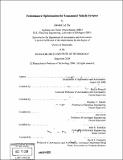| dc.contributor.advisor | Emilio Frazzoli, Munther A. Dahleh and Eric Feron. | en_US |
| dc.contributor.author | Le Ny, Jerome | en_US |
| dc.contributor.other | Massachusetts Institute of Technology. Dept. of Aeronautics and Astronautics. | en_US |
| dc.date.accessioned | 2009-08-26T16:50:46Z | |
| dc.date.available | 2009-08-26T16:50:46Z | |
| dc.date.copyright | 2008 | en_US |
| dc.date.issued | 2008 | en_US |
| dc.identifier.uri | http://hdl.handle.net/1721.1/46557 | |
| dc.description | Thesis (Ph. D.)--Massachusetts Institute of Technology, Dept. of Aeronautics and Astronautics, 2008. | en_US |
| dc.description | Includes bibliographical references (p. 149-157). | en_US |
| dc.description.abstract | Technological advances in the area of unmanned vehicles are opening new possibilities for creating teams of vehicles performing complex missions with some degree of autonomy. Perhaps the most spectacular example of these advances concerns the increasing deployment of unmanned aerial vehicles (UAVs) in military operations. Unmanned Vehicle Systems (UVS) are mainly used in Information, Surveillance and Reconnaissance missions (ISR). In this context, the vehicles typically move about a low-threat environment which is sufficiently simple to be modeled successfully. This thesis develops tools for optimizing the performance of UVS performing ISR missions, assuming such a model.First, in a static environment, the UVS operator typically requires that a vehicle visit a set of waypoints once or repetitively, with no a priori specified order. Minimizing the length of the tour traveled by the vehicle through these waypoints requires solving a Traveling Salesman Problem (TSP). We study the TSP for the Dubins' vehicle, which models the limited turning radius of fixed wing UAVs. In contrast to previously proposed approaches, our algorithms determine an ordering of the waypoints that depends on the model of the vehicle dynamics. We evaluate the performance gains obtained by incorporating such a model in the mission planner.With a dynamic model of the environment the decision making level of the UVS also needs to solve a sensor scheduling problem. We consider M UAVs monitoring N > M sites with independent Markovian dynamics, and treat two important examples arising in this and other contexts, such as wireless channel or radar waveform selection. In the first example, the sensors must detect events arising at sites modeled as two-state Markov chains. In the second example, the sites are assumed to be Gaussian linear time invariant (LTI) systems and the sensors must keep the best possible estimate of the state of each site. | en_US |
| dc.description.abstract | (cont.) We first present a bound on the achievable performance which can be computed efficiently by a convex program, involving linear matrix inequalities in the LTI case. We give closed-form formulas for a feedback index policy proposed by Whittle. Comparing the performance of this policy to the bound, it is seen to perform very well in simulations. For the LTI example, we propose new open-loop periodic switching policies whose performance matches the bound.Ultimately, we need to solve the task scheduling and motion planning problems simultaneously. We first extend the approach developed for the sensor scheduling problems to the case where switching penalties model the path planning component. Finally, we propose a new modeling approach, based on fluid models for stochastic networks, to obtain insight into more complex spatiotemporal resource allocation problems. In particular, we give a necessary and sufficient stabilizability condition for the fluid approximation of the problem of harvesting data from a set of spatially distributed queues with spatially varying transmission rates using a mobile server. | en_US |
| dc.description.statementofresponsibility | by Jerome Le Ny. | en_US |
| dc.format.extent | 157 p. | en_US |
| dc.language.iso | eng | en_US |
| dc.publisher | Massachusetts Institute of Technology | en_US |
| dc.rights | M.I.T. theses are protected by
copyright. They may be viewed from this source for any purpose, but
reproduction or distribution in any format is prohibited without written
permission. See provided URL for inquiries about permission. | en_US |
| dc.rights.uri | http://dspace.mit.edu/handle/1721.1/7582 | en_US |
| dc.subject | Aeronautics and Astronautics. | en_US |
| dc.title | Performance optimization for unmanned vehicle systems | en_US |
| dc.type | Thesis | en_US |
| dc.description.degree | Ph.D. | en_US |
| dc.contributor.department | Massachusetts Institute of Technology. Department of Aeronautics and Astronautics | |
| dc.identifier.oclc | 420309441 | en_US |
